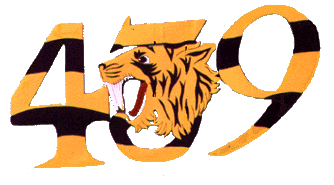|
History
of
 Squadron Squadron
  
Chapter
VI
Winter in the Netherlands
November 1944 January
1945
F/L Johnny Carr took temporary command of No. 439 for a few days until S/L J.H. Beatty arrived from England to replace Crosby. Jim had already completed one tour in the wing as a flight commander with No. 440
(1)
Squadron and, after a period of rest, was now beginning a second tour of ops. Other recruits for the squadron
were F/O J.W. Bullock, F/L A.W. Breck (also beginning a second tour), and WO1 L.S. Horrocks.
F/L C.L. Shaver was named "B" Flight commander in succession to Joe Cote, missing on the 14th. On 23
January, the day after S/L Crosby was brought down over Uetterath, his squadron again made three operations, once in support of the Army and twice on rail
interdiction. The first of the rail jobs did not run quite according to plan although the results were satisfactory. After taking off, the nine aircraft became separated
as they climbed through 10/10ths cloud, and only three reached the original objective on the line north east of Arnhem. Two hits were made on the rails. The other six pilots made three direct hits on an alternative target, the line north of Wesel. Three more cuts were scored on the second show when the rail line running west from Almelo, Holland, was bombed by F/O Bill Davis's
formation.
(1) He was the first member of that squadron to reach the end of a tour, on 17 October 1944.
|
Intentionally
left blank
|
Intentionally
left blank
|
Then the squadron returned to the Second Army front
along the Roer to dive bomb Porselen village with unreported results. Again on the 24th, for the third successive day, No. 439 was out three times, twice to attack rails (one cut on the Dorsten Borken line; second mission abortive due to dense clouds), and once to support the Army. The latter target was a large factory east of
Heinsberg, in which enemy mortars were concealed. After receiving sixteen direct hits, smoke and fire gushed from several
sections of the plant. The pilots commented that their dives were carried out
"without the usual flak."
This operation was the last in the current Army support series. The weather clamped down for several days and by the 28th the Army had completed its task of eliminating the enemy salient west of the
Roer. For a fortnight the squadron concentrated on rail interdiction and armed
recces. Despite unfavourable weather on the morning of the 26th F/O Lyal Shaver led a section into the Coesfeld area where they found conditions better than
expected. They also discovered some rail traffic with the result that two locomotives and two freight cars were peppered with cannon
strikes.
|
On the way home P/O Don
Elsley, one of the new pilots,developed engine trouble which finally forced him
to crashland within our lines. An iron fence and a ditch did considerable damage to the radiator, wing and fuselage of the Typhoon, but the pilot was uninjured. When Shaver reported the weather
"serviceable" and some game abroad, F/O Bill Davis's section, which had remained in readiness at the end of the runway, took off to lend a hand.
They too found a train standing on the line south of Coesfeld and made two passes at it, damaging the locomotive and eight cars.
"There was very little flak except for a lonely 2O mm. type who quickly ceased firing as soon as he knew our boys meant business."
  
Copyright
©1998-2016 Michael T. Melnick. All rights reserved
the
unofficial homepage of  Tiger
Squadron Tiger
Squadron
.
.
|
|